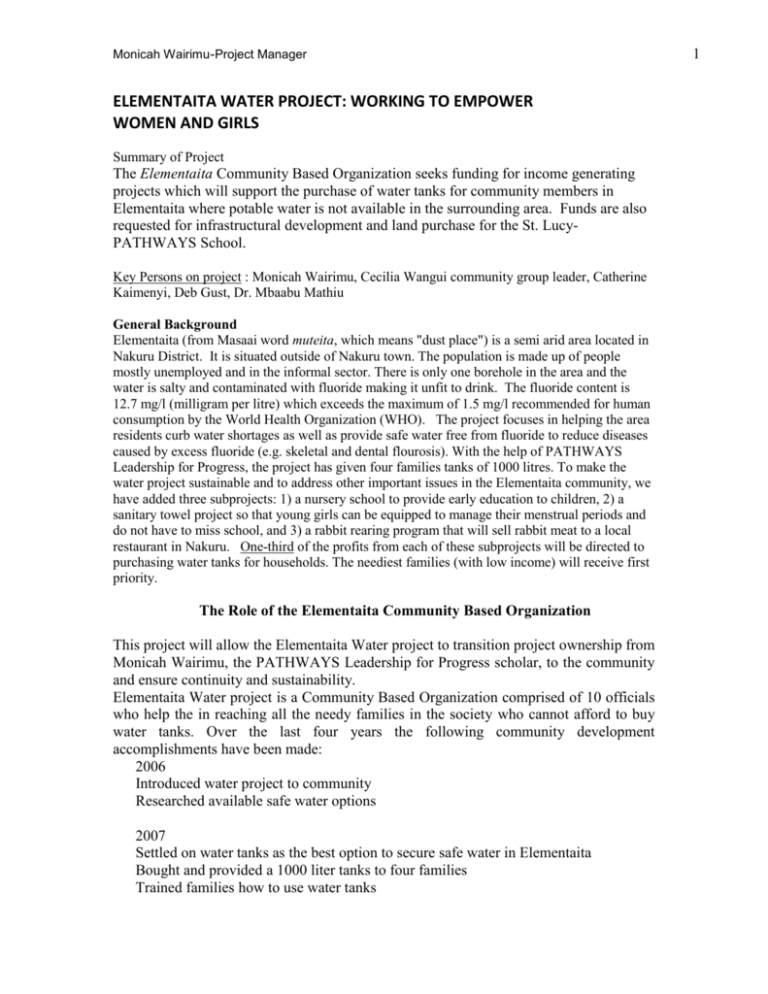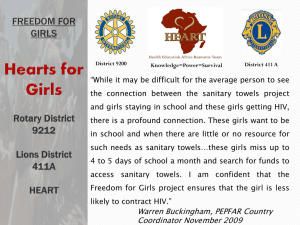(projdoc).
advertisement

Monicah Wairimu-Project Manager ELEMENTAITA WATER PROJECT: WORKING TO EMPOWER WOMEN AND GIRLS Summary of Project The Elementaita Community Based Organization seeks funding for income generating projects which will support the purchase of water tanks for community members in Elementaita where potable water is not available in the surrounding area. Funds are also requested for infrastructural development and land purchase for the St. LucyPATHWAYS School. Key Persons on project : Monicah Wairimu, Cecilia Wangui community group leader, Catherine Kaimenyi, Deb Gust, Dr. Mbaabu Mathiu General Background Elementaita (from Masaai word muteita, which means "dust place") is a semi arid area located in Nakuru District. It is situated outside of Nakuru town. The population is made up of people mostly unemployed and in the informal sector. There is only one borehole in the area and the water is salty and contaminated with fluoride making it unfit to drink. The fluoride content is 12.7 mg/l (milligram per litre) which exceeds the maximum of 1.5 mg/l recommended for human consumption by the World Health Organization (WHO). The project focuses in helping the area residents curb water shortages as well as provide safe water free from fluoride to reduce diseases caused by excess fluoride (e.g. skeletal and dental flourosis). With the help of PATHWAYS Leadership for Progress, the project has given four families tanks of 1000 litres. To make the water project sustainable and to address other important issues in the Elementaita community, we have added three subprojects: 1) a nursery school to provide early education to children, 2) a sanitary towel project so that young girls can be equipped to manage their menstrual periods and do not have to miss school, and 3) a rabbit rearing program that will sell rabbit meat to a local restaurant in Nakuru. One-third of the profits from each of these subprojects will be directed to purchasing water tanks for households. The neediest families (with low income) will receive first priority. The Role of the Elementaita Community Based Organization This project will allow the Elementaita Water project to transition project ownership from Monicah Wairimu, the PATHWAYS Leadership for Progress scholar, to the community and ensure continuity and sustainability. Elementaita Water project is a Community Based Organization comprised of 10 officials who help the in reaching all the needy families in the society who cannot afford to buy water tanks. Over the last four years the following community development accomplishments have been made: 2006 Introduced water project to community Researched available safe water options 2007 Settled on water tanks as the best option to secure safe water in Elementaita Bought and provided a 1000 liter tanks to four families Trained families how to use water tanks 1 Monicah Wairimu-Project Manager 2 2009 Developed curriculum for nursery school Recruited two fulltime teachers Enrolled 80 students Three Project Proposals for 2010: Specific Project Objectives/Goals 1. To construct 10 rabbit hutches and purchase 8 breeder rabbits (Ksh 45,000; US$ 600) for women’s group. 2. To purchase materials for young girls to make and sell sanitary towels (Ksh. 30,000; US$ 400). 3. To purchase of land for school and construct building for young children, especially girls and orphans (Ksh. 225,000; US$ 3000). Total for the three projects will be Ksh 288,000; US$ 3840 Ksh = Kenyan Shilling Project One: Construction of rabbit hutches and purchase of breeder rabbits Introduction and project plans In the nearby town (Nakuru) there is a restaurant which sells rabbit based meals and is a ready market for the rabbits. To help provide a source for their rabbit meat, the restaurant staff visited local communities to train them on how to raise rabbits for food. Some of the members of the our group, Elementaita women’s group were trained hence they will be instrumental as we start a rabbit rearing project to earn income to support their children in nursery school and to provide water tanks to the community. Budget Material cost for rabbit hutches Ksh. 34,000(US$ 454) Labour cost Ksh. 1,000 (US$ 13) Rabbits Ksh. 10,000 (US$ 133) TOTAL COST Ksh. 45,000 (US$ 600) Project Two: Purchase of materials to make sanitary towels Introduction and project plans The aim of this project is to train young girls in Elementaita on how to make reusable sanitary towels. This project aims to reach out to girls who skip classes because they cannot afford the sanitary pads. Disposable pads are very expensive and alternatives don't seem to exist for most girls. They often just stay home for the 5-10 days per month that they have their menses, rather than be embarrassed. This cuts heavily into their education. In the sanitary project, girls will learn new skills of making the pads which they can use for themselves as well as sell to others hence be a source of income for them. The project will help the girls to concentrate in their studies which will improve their performance in school and generate income which can be used to help with their school fees in secondary school. Monicah Wairimu-Project Manager 3 Budget Material, buttons, snaps for sanitary towels Advertising Packaging TOTAL COST Ksh. 18,000 (US$ 240) Ksh. 5,000 (US$ 67) Ksh. 7,000 (US$ 93) Ksh. 30,000(US$ 400) Project Three: Purchase of land for school and construction of school building Introduction and project plans St. Lucy –Pathways school was started in 2009. Due to limited funds we were not able to acquire land and build a structure. Since there was high demand for quality education and the local public school was overcrowded, the Catholic Church gave us the community church to use during the week. A major challenge has been lack of space as we have had to partition the hall with a curtain in order to serve as two classrooms. Buying the land and building a structure with 2 classrooms will help to improve early education for the children in Elementaita, especially girls and orphans. Budget Land (2 acres) Rafts and Trusses Roofing Nails and hardware Labor TOTAL COST Ksh. 180,000 (US$ 2400) Ksh. 15,000 (US$ 200) Ksh. 15,000(US$ 200) Ksh.10, 000 (US$ 133) Ksh. 5,000 (US$ 67) Ksh. 225,000 (US$ 3000) Expected Outcomes Project One: Construction of rabbit hutches and purchase of breeder rabbits At every four months female rabbits can give birth of up to 10 offspring. After the first sale, the women’s group will earn Ksh. 80,000(US $1067). One-third of the profits will be ploughed back in the project for the purpose of expansion (1/3 will go to water project and 1/3 to women. The Chairlady, Treasurer and Secretary of the group will be responsible of handling money that will be generated from the project. Treasures will be responsible of keeping proper records of how money has been spent. Project Two: Purchase of materials to make sanitary towels From the initial funding, the project will not generate any money since the girls will make sanitary towels for their own use. When the project is established in 2-3 years, 1/3 of the profits will go to the water project. Project Three: Purchase of land for school and construction of building We expect to raise Ksh 6,000 per term through school fees which will be Ksh 18,000(US $240) per year. Fifty percent of the profits will go toward the purchase of water tanks. Remaining Monicah Wairimu-Project Manager 4 Evaluation Plan Project One: Construction of rabbit hutches and purchase of breeder rabbits We plan to evaluate the success of this project quarterly as follows; Number of rabbits reared Number of rabbits sold Profit per rabbit Number of women involved and who are directly benefiting under the project Number of parents able to pay nursery school fees Overall Cost: Return ratio for the project Project Two: Purchase of materials to make sanitary towels We plan to evaluate the success of this project quarterly by monitoring the following; Number of girls who will be trained on sanitary making Profit per sanitary towel made and sold Reduction in absenteeism among girls engaged in project Number of girls who use the skills for commercial purpose Number of girls who support their family from the income earned and average amount contributed to family Project Three: Purchase of land for school and construction of building We plan to evaluate the success of this project by monitoring the following; Number of children in the school Number of girls in the school Average grades before and after move to new school building Overall ● Amount of money collected from three projects for water tank fund 1/3 of profits from rabbit project,1/2 of profits from the school project and 1/3 of profits from sanitary project ● Number of water tanks provided to needy families 4 at the moment, we plan to be buying at least 5 every year. ● How needy families are using their water tanks For consumption-cooking and drinking Growing vegetables for own family consumption or selling to the community. ● How recipient family’s living standards have changed as a result of having the water tank Monicah Wairimu-Project Manager They no longer walk for many kilometers to fetch water. Access to safe water The time they used to spend in fetching water they use it in their farms or any other domestic job. For those who are growing vegetables water has become a source of income. No water borne diseases. The water they used to fetch in the river was at times contained. 5






